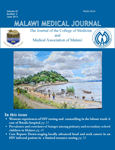
|
Malawi Medical Journal
College of Medicine, University of Malawi and Medical Association of Malawi
ISSN: 1995-7262
Vol. 30, No. 4, 2018, pp. 256-261
|
 Bioline Code: mm18051
Bioline Code: mm18051
Full paper language: English
Document type: Research Article
Document available free of charge
|
|
|
Malawi Medical Journal, Vol. 30, No. 4, 2018, pp. 256-261
| en |
Prevalence of malaria in HIV positive and HIV negative pregnant women attending antenatal clinics in south eastern Nigeria
Ezeoke, Uchechukwu; Ndu, Anne; Omotowo, Babatunde; Okoye, Micheal; Mbachu, Chinyere & Agwu-Umahi, Olanike
Abstract
Introduction
Globally, malaria in pregnancy is a public health challenge. Malaria and HIV are among the two most important diseases contributing
to the global health burden of our time. HIV positive pregnant women are at increased risk of all the adverse outcomes of malaria in
pregnancy.
Objective
The objective of this study was to compare malaria parasitaemia between HIV positive and HIV negative pregnant women attending
antenatal clinics offering Preventing Maternal to Child Transmission (PMTCT) services in Enugu metropolis, south-eastern Nigeria.
Methods
A descriptive cross sectional study was conducted among 200 HIV positive and 200 HIV negative pregnant women attending antenatal
clinics in Enugu. Two out of five hospitals that provide PMTCT services were selected through balloting. Finger pricked blood samples
were collected and thick blood films were examined for malaria parasite using giemsa expert microscopy. A structured interviewer
administered questionnaire was used for data collection. Data was analysed using SPSS version 22.
Results
The HIV positive pregnant women (152) (76%) and HIV negative women (137) (68.5%) studied were mostly in the age range of
25-34 years. Mean gestational age of HIV positive and HIV negative participants were 23.4±10.7 and 23.2±10.1 weeks respectively
(P=0.001). The prevalence of malaria infection among HIV positive pregnant mothers was 81% (162/200) and 75% (150/200) among
HIV negative pregnant women (P < 0.001). The HIV positive mothers had more moderate parasitaemia (86/200: 53.1%) compared
to 43/200: 28.7% in HIV negative mothers (P<0.001). Even though more HIV positive mothers (54.5%) used insecticide treated
nets ITNs during pregnancy compared to 41.5% in HIV negative mothers, moderate malaria parasitaemia was higher in HIV positive
mothers. HIV positive nulliparous pregnant women had the highest rate of malaria parasitaemia (32/36: 88.9%).
Conclusion
Moderate malaria parasitaemia was higher among HIV positive pregnant women. All malaria preventive strategies should be intensified
in pregnancy as ITNs provided little protection.
Keywords
Malaria parasitaemia; HIV; pregnant women; Enugu; Nigeria
|
| |
© Copyright 2018 - The College of Medicine and the Medical Association of Malawi
Alternative site location: http://revista.uft.edu.br/index.php/jbb/index
|
|
